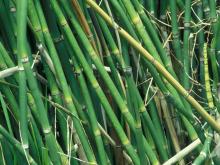Wildflowers, Grasses and Other Nonwoody Plants
Media

Species Types
Scientific Name
Panax quinquefolius
Description
Wild and cultivated ginseng produce an annual crop in the United States and Canada valued in excess of $25 million, but overzealous collection is causing serious concern about the survival of American ginseng in the forest ecosystem.
Media

Species Types
Scientific Name
Viola sororia
Description
The common violet can be violet, white, or white with violet mottling or spots. One of 17 species or violets in Missouri, it occurs statewide in a variety of habitats. Note its heart-shaped or rounded, scalloped leaves, and (usually) the presence of hairs on stems and/or foliage.
Media

Species Types
Scientific Name
Viola pubescens (formerly V. pensylvanica)
Description
The yellow violet is Missouri's only all-yellow violet. This native wildflower is less common than violet violets. Look for it in low woods, rich slopes, and wooded floodplains.
Media

Species Types
Scientific Name
Houstonia pusilla (H. minima; Hedyotis crassifolia)
Description
Small bluet is a mat-forming winter annual that can color entire lawns blue with its tiny flowers. You can start learning to recognize it by noting the reddish-purple color at the center of the blue-violet flowers.
Media

Species Types
Scientific Name
Oxalis violacea
Description
Missouri has one introduced and four native wood sorrels. Violet wood sorrel is the only one that has magenta or lavender flowers.
Media

Species Types
Scientific Name
Viola bicolor
Description
Johnny-jump-up is a flat-faced violet whose small flowers are a washed-out blue or violet with a very light yellow or white center. Look for it in fields, meadows, glades, rights-of-way, disturbed sites, and possibly your front lawn.
Media

Species Types
Scientific Name
Equisetum (3 spp. in Missouri)
Description
Horsetails, or scouring rushes, are in the genus Equisetum. They’re easy to recognize with their jointed, hollow stems. Like ferns, they reproduce via spores instead of flowers and seeds.
Media

Species Types
Scientific Name
Dryopteris marginalis
Description
Marginal shield fern is an evergreen fern with scaly rhizomes and leaf stalks. It grows in bouquet-like clusters on shaded ledges of sandstone bluffs and rock outcrops.
Media

Species Types
Scientific Name
Asplenium platyneuron
Description
Ebony spleenwort is a common forest-floor fern with wiry, shiny, dark brown leaf stalks and a ladderlike series of dark green, narrowly oblong leaflets.
Media

Species Types
Scientific Name
Adiantum spp. (2 in Missouri)
Description
Maidenhair ferns are distinctive and beautiful. Their leaflet veins divide by twos over and over, forming a fan pattern.
See Also
About Wildflowers, Grasses and Other Nonwoody Plants in Missouri
A very simple way of thinking about the green world is to divide the vascular plants into two groups: woody and nonwoody (or herbaceous). But this is an artificial division; many plant families include some species that are woody and some that are not. The diversity of nonwoody vascular plants is staggering! Think of all the ferns, grasses, sedges, lilies, peas, sunflowers, nightshades, milkweeds, mustards, mints, and mallows — weeds and wildflowers — and many more!





















